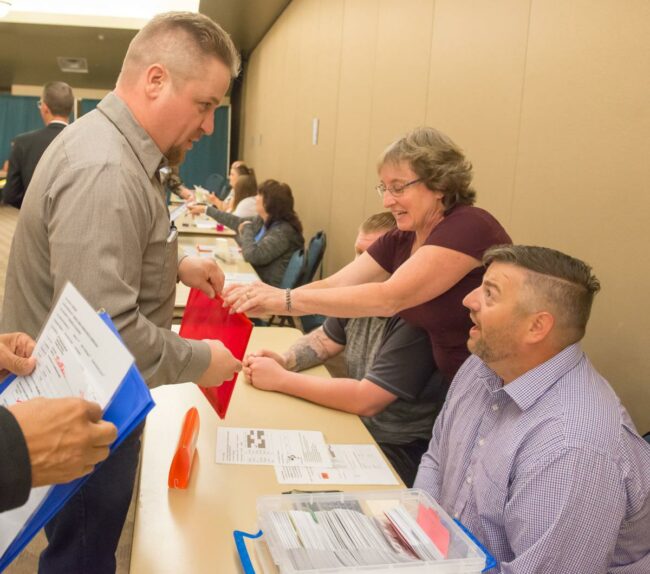
Participants in a reentry simulation in Roseburg, Ore., perform the tasks required to begin their new lives.
Want to know what it’s like to leave prison and begin to reintegrate into society? Is it possible to really understand the difficulties and challenges involved? Now at least people can get a basic understanding of the process by attending one of the reentry simulation programs popping up around the country.
Each program, whether offered by a church, nonprofit or government agency, is a bit different but all have the same goal – to walk in the shoes of those in reentry. And it’s much more difficult than anyone could ever imagine.
Participants take on new identity
Reentry simulations replicate in an hour or two what returning citizens must accomplish during their first month back in society. Participants take on the identity of someone who was incarcerated and are given information on their offence(s), living situation, work details, if any, and anything else they need to know. They also receive a list of tasks to complete.
The events take place in a large meeting room lined with tables. Each table is supported by a volunteer who represents a service that the reentry participants will need to access. These include probation, the court, an employer, treatment, DMV, housing, job training, social security, transportation and a community support organization. Volunteers are given instructions on how to serve the people who come to their table and told to not be accommodating.
Participants must go through the various tasks, and if they can’t complete them, they’re out.
What actually happens in a reentry simulation
Christy Grammon is executive director of True North Star Ministries in Roseburg, Ore. and now also organizes reentry simulations. She talks about her first experience.
“I was Amber. I had a part time job, six bus tickets, $200 in cash, a couple of things to pawn and was in transitional housing. Although I didn’t have a state I.D., I had a social security card,” she says. “You had to have a bus ticket to get services. I had six tickets for that week. There was a bus terminal to buy more.”
She went through a few of the initial tasks. “Then I picked a card at the treatment table that said I didn’t pass and had to have treatment. By then I was running out of time, and I had to get to my job. There was a long line at my job to fill out the entry paper work. So I decided to leave work and to go the probation office, but I didn’t have a bus ticket. So I was out the first week.”
Experience can make participants shocked and angry
Daniel Dinan, sales manager at DNS Call Centers in Roseburg, Ore., was a participant in Grammon’s reentry simulation. Like many others, the experience made him shocked and angry.
“Participants were saying, “Oh my gosh, this is what really goes on? Why are we doing this to people? Why do we make it so difficult?,” he says. “It’s a mixture of frustration. A mixture of disgust for why we treat people like this. People were thinking ‘Look what we’re missing in our community. We’re creating a cycle for this to continue, and I’m part of it.’”
Dinan, reflecting on his experience, says, “You understand that there’s a problem, but you don’t understand how difficult it is. Once you live in their moment, you walk in their shoes, it’s very powerful.”
Do your own reentry simulation program
Anyone interested in doing a program for their company or organization can check out the website of the United States Attorney’s Office of the Northern District of West Virginia. It explains the agency’s reentry simulation program and allows anyone who would like to do their own program to download the materials they will need.
Those interested can also contact Grammon, who is considering conducting her reentry simulation programs throughout the U.S. “Invite us to come train you. We need to equip every state to do this. Even the Rotary Club and the chambers of commerce. And I’d like to see the larger businesses do it for their staff,” she says. Grammon can be reached at tnsministries@gmail.com.

